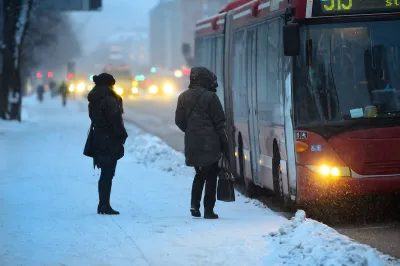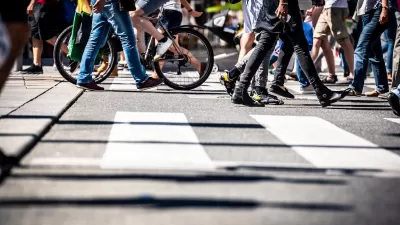Unsurprisingly, people are less likely to use transit during extreme weather events, which are becoming more common around the country.

Extreme weather contributes to a drop in transit ridership, a new study reveals, showing that “America needs to better climate-proof its transit networks and encourage more people to choose shared modes now.”
As Kea Wilson explains in Streetsblog USA, “A recent study of 43 major U.S. transit networks revealed that ridership dropped during long stretches of rain, heat, or other prolonged extreme weather events that scientists link to climate change, at least in the 17 years between when the National Transit Database began collecting stats and 2019, the last year before the pandemic decimated ridership.”
As extreme weather events become more common, this could hinder efforts to encourage transit use and reduce transportation emissions. Weather also impacts transit infrastructure: “During bad snow and rain storms, buses can get snarled in the same traffic as cars, and rail tracks can warp in intense heat, forcing agencies to run trains more slowly or cancel trips outright, leaving even those who would pay the fare with no ride to take.”
Nicole Ngo, lead author on the study, says that transit agencies must significantly expand their efforts to provide shade, cooling greenery, and other climate-controlling measures at bus stops — “and doing so at a vast scale, considering that only about one-fifth of U.S. bus stops even have basic shelters now.”
FULL STORY: How Climate Change Is Hurting Transit Ridership

Alabama: Trump Terminates Settlements for Black Communities Harmed By Raw Sewage
Trump deemed the landmark civil rights agreement “illegal DEI and environmental justice policy.”

Study: Maui’s Plan to Convert Vacation Rentals to Long-Term Housing Could Cause Nearly $1 Billion Economic Loss
The plan would reduce visitor accommodation by 25% resulting in 1,900 jobs lost.

Why Should We Subsidize Public Transportation?
Many public transit agencies face financial stress due to rising costs, declining fare revenue, and declining subsidies. Transit advocates must provide a strong business case for increasing public transit funding.

Paris Bike Boom Leads to Steep Drop in Air Pollution
The French city’s air quality has improved dramatically in the past 20 years, coinciding with a growth in cycling.

Why Housing Costs More to Build in California Than in Texas
Hard costs like labor and materials combined with ‘soft’ costs such as permitting make building in the San Francisco Bay Area almost three times as costly as in Texas cities.

San Diego County Sees a Rise in Urban Coyotes
San Diego County experiences a rise in urban coyotes, as sightings become prevalent throughout its urban neighbourhoods and surrounding areas.
Urban Design for Planners 1: Software Tools
This six-course series explores essential urban design concepts using open source software and equips planners with the tools they need to participate fully in the urban design process.
Planning for Universal Design
Learn the tools for implementing Universal Design in planning regulations.
Smith Gee Studio
Alamo Area Metropolitan Planning Organization
City of Santa Clarita
Institute for Housing and Urban Development Studies (IHS)
City of Grandview
Harvard GSD Executive Education
Toledo-Lucas County Plan Commissions
Salt Lake City
NYU Wagner Graduate School of Public Service





























